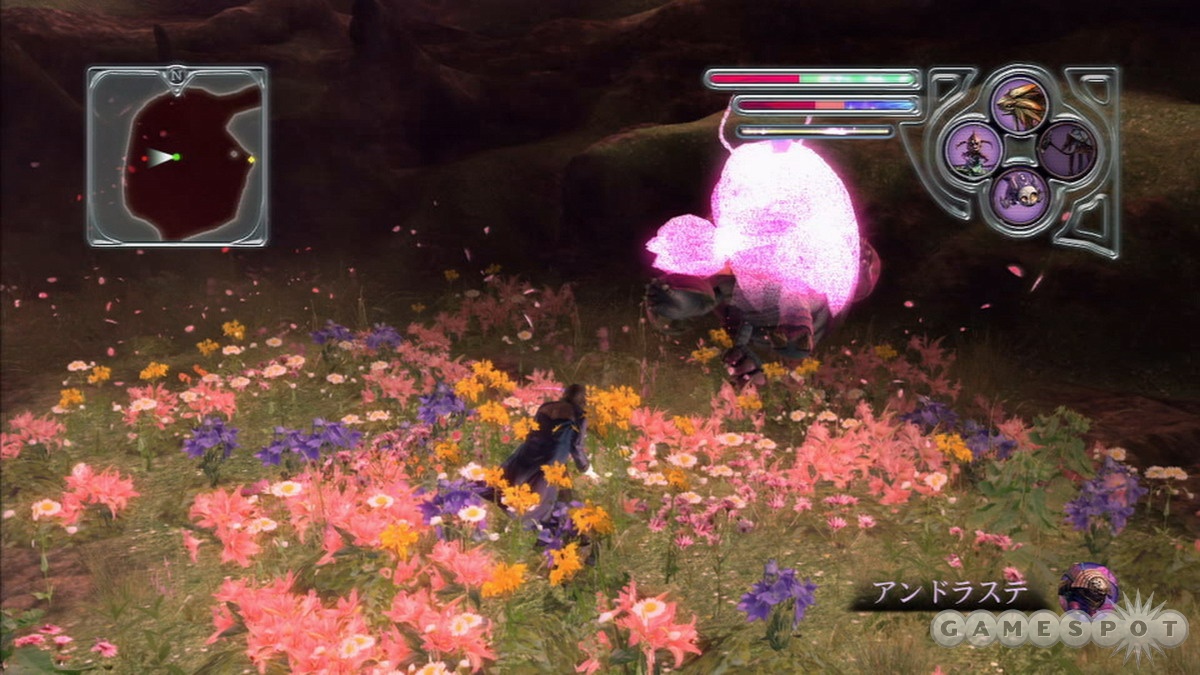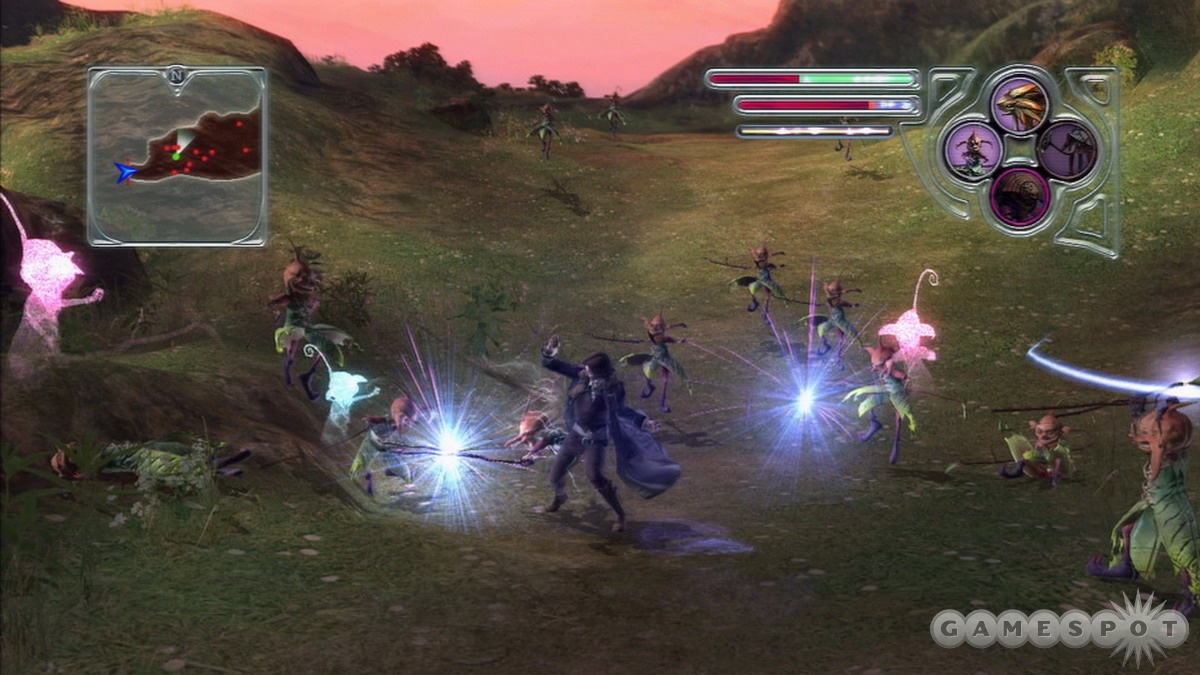Folklore Import Hands-On
We travel to Netherworld and absorb the souls of monsters in the Japanese version of Sony's upcoming action role-playing game.
We've been looking forward to Folklore ever since we first got our hands on it at last year's Tokyo Game Show, when it was known as Monster Kingdom: Unknown Realms. Folklore is headed to territories outside of Japan at some point, but with no release date confirmed, we could wait no longer and decided to import the finished Japanese game, which, after a few title changes, was ultimately released as Folk's Soul. The game has too much Japanese text to be considered import-friendly, but while we're still none the wiser where the storyline is concerned, we still had plenty of fun playing through the combat-oriented action sequences.
What we do know of Folklore's story comes from the few prerendered cutscenes we've encountered, which, unlike other areas of the game, are voiced in English with Japanese subtitles. The playable characters Ellen and Keats meet when Ellen, visiting the remote village of Lemrick after receiving what appears to be a letter from her long-dead mother, gets spooked and calls Keats for help. Keats works as a reporter for an occult magazine called Unknown Realms, so when Ellen tells him that she's being killed by some kind of spirit, his curiosity is piqued and he travels there. The pair meets atop a nearby cliff, where they witness what appears to be an elderly woman--possibly Ellen's mother--toppling off the cliff to her death. Things are rarely what they seem in "the village of the deceased," though, which becomes apparent shortly after you choose which character you want to start the game as and set about exploring the area.
The Irish shoreline that you get to explore en route to Lemrick is quite picturesque, which makes it a little frustrating that you're only able to explore within the confines of predetermined paths and such. When you reach the village you'll find that it's more or less deserted until you wander into the local tavern, The Little Neighbors. Inside you'll meet a number of bizarre patrons who are more than happy to engage with you in Japanese text-driven conversation. An anthropomorphic rat, two blue-skinned women who float in midair, and a barman who looks like a googly-eyed version of The Addams Family's Cousin Itt are among the more memorable characters and, upon leaving the tavern, you'll meet an equally strange fellow who acts as your guide through the early portion of the game. When playing as Keats our guide was a well-dressed invisible man named Belgae, but when playing as Ellen we were accompanied for a time by a dancing scarecrow in a union-flag shirt and a jester's cap.

We're not really sure how much useful information our guides were imparting during the lengthy conversations that ensued, but the end result for both playable characters was that they stepped through a portal into the first of Folklore's Netherworld realms. There are seven realms in Netherworld, including everything from a gigantic labyrinth to an undersea city, but the first is a far less fantastical map comprising forests, fields, and paths connecting them. The camera's position is fixed in a lot of the areas that you'll be walking through, which serves to emphasize how restricted your opportunities for exploration are, but when you encounter folk (monsters, essentially), it'll generally be in one of the open areas in which you're given the abilities to move the camera and to lock onto targets. All of the other abilities at your disposal will come from folks whose souls you've captured and absorbed after defeating them in combat. The first two folks you'll absorb are a small goblinlike creature called a Pouke that gives you the ability to perform a basic melee attack, and the shield-generating Killmoulis, which has the appearance of a purple rodent that jumps around using its tail.
To capture additional folks you need to beat them to within an inch of their life, at which point their souls will visibly try to leave their bodies. The souls are blue initially and then turn red as you continue to deal damage, alerting you to the fact that the soul is vulnerable to capture. Tapping the R1 button when red souls are in the area sees your current character launching a magical lasso of some kind--it's somewhat reminiscent of the "streams" in Ghostbusters--which will automatically latch onto as many vulnerable enemies as are in your field of vision. With the souls caught in your lasso you'll need to reel them in, which is achieved by moving the Sixaxis up and down--effectively beating them into submission.
You can equip up to four folks at a time, mapping one to each of the Sixaxis controller's face buttons. We've absorbed only around eight or nine of Folklore's 105 creatures to date, but already it's clear that their abilities are varied enough to make your choices count. Folks in our menagerie right now include the large catlike Treant, which charges toward enemies to perform a powerful attack; a tall creature with a long neck that slams its head down on the ground to stun enemies in the surrounding area; and a large beetle that curls up in a ball and knocks enemies down as it rolls toward them. You can pause the game and swap your folks around in the middle of a battle if you realize that you've chosen poorly, and although we've rarely needed to thus far, we suspect this will be quite important later in the game. Every folk ability has a magic cost associated with it, and so simply opting to equip all of your most powerful folks is rarely a good idea because their abilities have higher costs and you'll spend half your time waiting for your magic pool to replenish.

Scattered throughout the Netherworld are large, glowing flowers that act as save points where you can replenish your health and, if you wish, exit Netherworld via a magical doorway back to Lemrick. The village also has a save point that you can use at any time, located in the surprisingly well-furnished cave that both Ellen and Keats use as a home base. In addition to the save point, which takes the form of a desk, the cave has a couch inside it that you can sleep on anytime you want to trigger the transition from day to night or vice versa. We haven't completely figured out the significance of night and day in Folklore, but we can tell you that the village and its inhabitants aren't nearly as strange while the sun is shining as they are by moonlight.
In addition to the story mode that we've been playing thus far, Folklore features an unlockable "dungeon trial" mode in which you'll get to design your own dungeons and upload them for other players to explore. We look forward to bringing you more information on dungeon trial mode and on everything else Folklore-related as soon as it becomes available.
Got a news tip or want to contact us directly? Email news@gamespot.com
Join the conversation